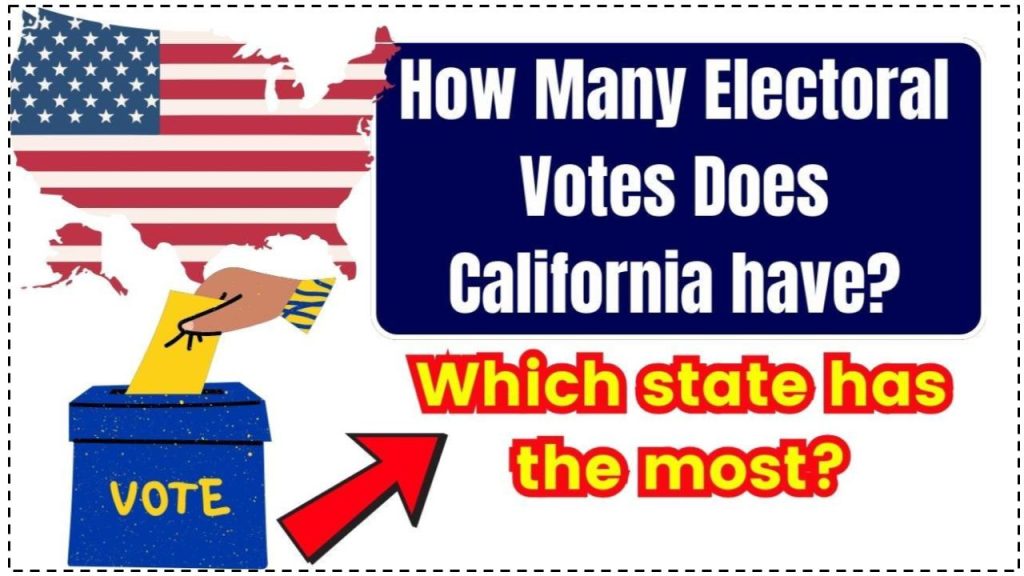
How Many Electoral Votes Does California Have: The U.S. Electoral College plays a pivotal role in deciding presidential elections, influencing both campaigns and voter impact. California, the most populous state, holds the most electoral votes, making it a key player in this unique election process. Understanding how these votes are allocated, their significance, and the roles they play in American democracy is crucial for any engaged citizen. Here, we’ll explore California’s electoral votes, how the U.S. Electoral College functions, and why this system matters.
Electoral Votes Does California have
| Topic | Details |
|---|---|
| California’s Electoral Votes | California holds 54 electoral votes, the most of any state in the U.S. |
| Electoral College System | A total of 538 electoral votes; 270 were needed to win the U.S. presidency |
| Largest States by Electoral | California (54), Texas (40), Florida (30), New York (28) |
| Determination Factors | Based on U.S. House and Senate representation per state |
| Importance | States with higher electoral votes often influence candidate strategies in presidential elections |
| Source | Official U.S. Government Reference |
The Electoral College system, with California leading as the state with the most electoral votes, continues to play a crucial role in shaping U.S. presidential elections. This unique system ensures balanced representation, influences campaign strategies, and reflects changes in population distribution. While some debate its efficacy, the Electoral College remains integral to American democracy. Understanding this process not only empowers voters but also highlights the dynamics of American governance.
What Are Electoral Votes?
Electoral votes represent the mechanism by which U.S. presidents are elected. Unlike other elections, where a popular vote decides the winner, the presidential election uses the Electoral College, a unique system developed during the formation of the United States. Each state’s number of electoral votes equals its total representation in Congress (the sum of its U.S. Senators and Representatives). This structure means populous states like California hold significantly more power in terms of electoral influence than smaller states.
Why California Holds the Most Electoral Votes
With a substantial population of over 39 million people, California has the largest delegation in the House of Representatives (52), alongside its two Senate seats. This gives California a total of 54 electoral votes, placing it at the top of all states.
State Breakdown of Electoral Votes
Here is a snapshot of some states with significant electoral vote counts:
- Texas: 40 electoral votes
- Florida: 30 electoral votes
- New York: 28 electoral votes
- Pennsylvania: 19 electoral votes
Because of their high vote counts, these states often become “battlegrounds” where candidates focus significant campaign resources.
The Basics of the Electoral College System
The U.S. Electoral College is a body of 538 electors who meet after the general election to officially elect the President and Vice President. Here’s a breakdown of the electoral vote process:
- Representation: Each state has electors equal to its Congressional representation.
- Election of Electors: Political parties in each state select electors before the general election.
- Casting Votes: In most states, the winner of the popular vote receives all the electoral votes.
- Majority to Win: A candidate needs at least 270 electoral votes to secure the presidency.
A Brief History of the Electoral College
The Electoral College was established by the Founding Fathers as a compromise between electing the President by a Congressional vote or by popular vote. The goal was to balance power between smaller and larger states, ensuring fair representation across the nation. This structure has endured for over 230 years, adapting as populations and political dynamics have shifted.
How Are Electoral Votes Determined?
Electoral votes are based on two main factors:
- Population Representation: House seats are distributed based on population, updated every 10 years through the Census.
- Senate Representation: Each state has two Senators, providing a consistent base.
For example, California has 52 House seats due to its large population, while states like Wyoming have just one. When combined with their Senate seats, California’s total reaches 54 votes, whereas Wyoming has only three.
Electoral Votes Influence Campaigns?
Candidates tailor their campaigns based on the influence of swing states with significant electoral votes, like Florida or Pennsylvania. In the 2020 election, for instance, both parties invested heavily in these regions because even a narrow victory could secure essential electoral votes, potentially tipping the balance.
Practical Examples
Consider California’s influence: In 2016, Democratic nominee Hillary Clinton won California by a large margin, contributing substantially to her popular vote lead, although she ultimately lost the presidency. Similarly, in 2020, President Joe Biden won California, boosting his electoral vote count significantly.
Swing States: The Key Players
While California is a stronghold for Democrats, swing states, or “battleground states,” change party affiliation frequently and have the potential to sway the election result. Here’s a look at the most impactful swing states in recent elections:
- Florida: 30 electoral votes
- Pennsylvania: 19 electoral votes
- Michigan: 15 electoral votes
- Wisconsin: 10 electoral votes
These states often decide the outcome due to their fluctuating political landscape.
Pros and Cons of the Electoral College
The Electoral College system has both advocates and critics. Here’s a quick overview:
Pros
- Balanced Representation: Ensures that less-populous states have a voice in national elections.
- Stability: Reduces the likelihood of constant recounts and instability in close popular vote scenarios.
- Focus on State Issues: Encourages candidates to address a wider range of state-specific concerns.
Cons
- Popular Vote Mismatch: The candidate with the most votes nationwide may not always win the presidency.
- Swing State Bias: Candidates may focus more on swing states, leading others to feel overlooked.
- Complexity: The process can be confusing, and critics argue it distances voters from directly electing their President.
Georgia Election Results 2024 – Check Voting Results, Exit Polls
US electoral votes by state 2024- Georgia and North Carolina Result
$1,600 Relief Package Coming In November For this State: Know Eligibility & Application Process
Historical Shifts and Trends in Electoral Votes
The distribution of electoral votes can change over time, often influenced by population shifts. For example, states like Texas have gained electoral votes over recent decades, while states in the Midwest have seen a decrease due to population declines.
- Growing States: Texas and Florida have increased their representation, gaining electoral votes.
- Decreasing States: States like Michigan and Ohio have seen reductions.
These shifts reflect changes in political power and influence as people relocate across the country.
FAQs On Electoral Votes Does California have
Q1: Can the popular vote differ from the Electoral College outcome?
Yes. It’s possible for a candidate to win the national popular vote but lose in the Electoral College. This happened in recent elections, like in 2000 and 2016.
Q2: Why doesn’t every vote directly elect the President?
The Electoral College was created as a compromise, balancing the influence of populous and less populous states. It ensures a distributed vote across the U.S. rather than centring power in heavily populated areas.
Q3: How often do electoral votes change for each state?
Every 10 years, after the Census, electoral votes are redistributed based on population changes.
Q4: Why does California have so many electoral votes?
California has a large population, which translates to more representation in the House of Representatives, and hence, more electoral votes.
Q5: What happens if no candidate receives 270 electoral votes?
If no candidate reaches 270 votes, the election moves to the House of Representatives, where each state delegation casts one vote for President.

